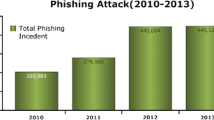Abstract
With the convergence of mobile communication network and Internet in depth, mobile Internet is penetrating into every field of people’s life. Smart phone bring us great convenience, but it also becomes the breeding ground for the spread of malicious codes. In this paper, we propose a trust transfer algorithm based on the ant colony optimization algorithm to calculate the trust degree between any two nodes in the social network. Afterwards, a defense model based on social computing is presented for mobile phone malware. The simulation results show that our trust transfer algorithm improves the computation accuracy of indirect trust value by 14.65% compared with the TidalTrust algorithm, and the patch transmission speed of our model is faster than that of others.
Similar content being viewed by others
References
Bulut E, Szymanski B K. Exploiting friendship relations for efficient routing in mobile social networks [J]. Parallel and Distributed Systems, IEEE Transactions on, 2012, 23(12): 2254–2265.
Suarez-Tangil G, Tapiador J E, Peris-Lopez P, et al. Evolution, detection and analysis of malware for smart devices [J]. Communications Surveys & Tutorials, IEEE, 2014, 16(2): 961–987.
Sahs J, Khan L. A machine learning approach to android malware detection [C] // Intelligence and Security Informatics Conference (EISIC), European. Odense: IEEE Press, 2012: 141–147
Sun X. Research on simulation and modeling of social network worm propagation [J]. Chinese Journal of Computer, 2011, 34(7): 1252–1261 (Ch).
Wei Q, Ren M, Chen G. Towards understanding dynamics of mobile phone worm propagation using social network analysis [C] // 2009 Eighth International Conference on Mobile Business. Piscataway: IEEE Press, 2009: 290–295.
Zhu Z, Cao G, Zhu S, et al. A Social Network Based Patching Scheme for Worm Containment in Cellular Networks [M]. New York: Springer-Verlag, 2012.
Iglesias J A, Tiemblo A, Ledezma A, et al. Web news mining in an evolving framework [J]. Information Fusion, 2016, 28: 90–98.
Parameswaran M, Whinston A B. Social computing: An overview [J]. Communications of the Association for Information Systems, 2007, 19(1): 762–780.
F-Secure. F-secure virus information pages: Cabir [EB/OL].[2016-11-08]. http://www.fsecure.com/v-descs/cabir.shtml.
Datatang. Email social NetWork data [EB/OL].[2016-11-08]. http://www.datatang.com/data/45061.
Jiang W, Wu J, Wang G, et al. Forming opinions via trusted friends: Time-evolving rating prediction using fluid dynamics [J]. IEEE Transactions on Computers, 2016, 65(4): 1211–1224.
Author information
Authors and Affiliations
Corresponding author
Additional information
Foundation item: Supported by the National Natural Science Foundation of China (91438117) and the Funding of Shanghai Key Laboratory of Financial Information Technology(2015)
Biography: SHI Leyi, male, Ph.D., Professor, research direction: network and information security, cyber defense, game theory, and mobile Internet
Rights and permissions
About this article
Cite this article
Shi, L., Liu, X. & Wang, Y. A defense model against mobile phone malicious codes based on social computing. Wuhan Univ. J. Nat. Sci. 22, 134–140 (2017). https://doi.org/10.1007/s11859-017-1226-5
Received:
Published:
Issue Date:
DOI: https://doi.org/10.1007/s11859-017-1226-5




